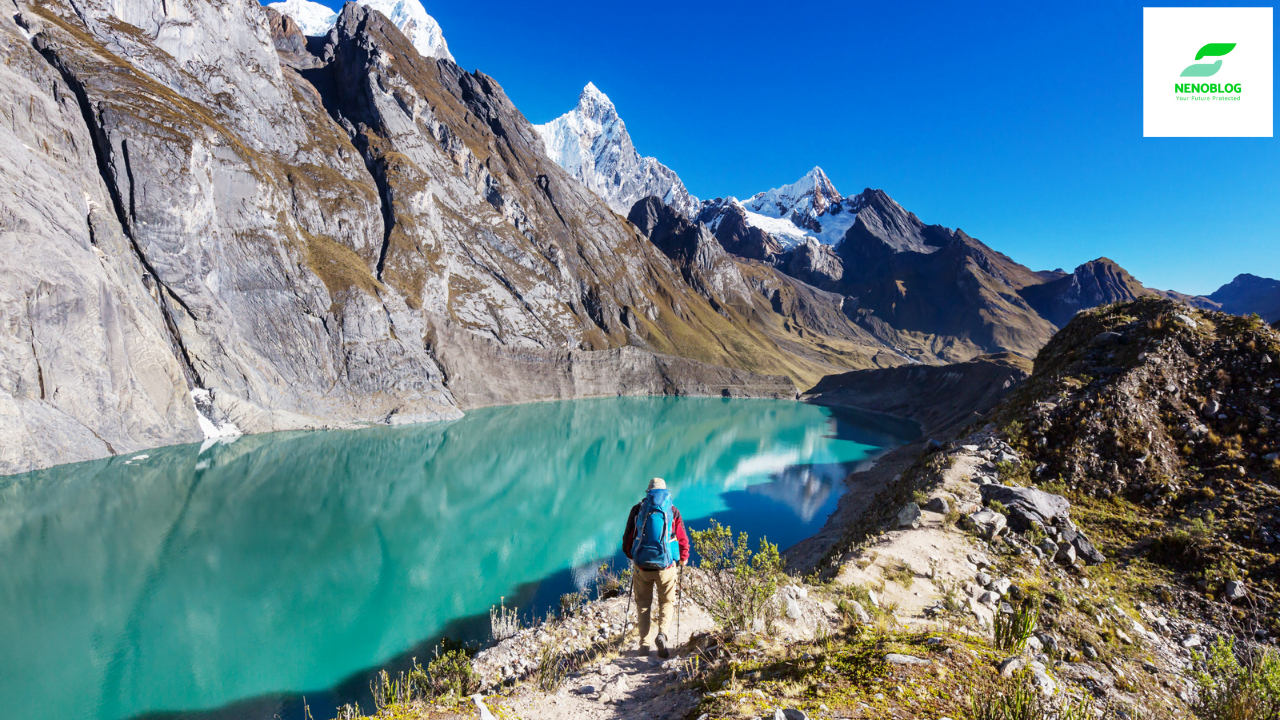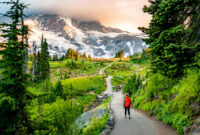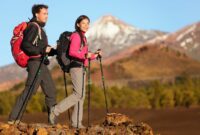Singles hiking trips offer a unique blend of adventure, self-discovery, and connection with nature. This guide explores the planning, safety, social aspects, and enriching experiences of solo hiking, empowering individuals to embark on fulfilling journeys into the wilderness. We’ll cover everything from crafting detailed itineraries and packing lists to navigating potential hazards and connecting with fellow adventurers.
From choosing the perfect location and mastering essential safety protocols to enhancing your solo experience through mindfulness and photography, this comprehensive resource aims to equip you with the knowledge and confidence needed for a memorable and safe solo hiking adventure. Whether you’re a seasoned hiker or a curious beginner, we provide practical tips and strategies to make your singles hiking trip both rewarding and enjoyable.
Safety & Risk Management on Singles Hiking Trips
Embarking on a solo hiking adventure offers unparalleled freedom and connection with nature, but it also necessitates a heightened awareness of safety and risk management. Successfully navigating the wilderness alone requires careful planning, preparedness, and a proactive approach to potential hazards. This section details strategies for mitigating risks and ensuring a safe and enjoyable solo hiking experience.
Communication Plans and Emergency Procedures
Effective communication is paramount during solo hikes. Before setting out, inform a reliable contact person—a friend, family member, or neighbor—of your planned route, estimated hiking times, and expected return. Provide them with a map of the trail and any relevant details, such as trailhead location and emergency contact numbers. Regularly check in with your contact person via phone or text message, especially at predetermined intervals. In case of an emergency, pre-arrange a specific signal or message that indicates a need for assistance. Consider carrying a personal locator beacon (PLB) or satellite messenger for reliable communication in areas with limited or no cell service. These devices can transmit your location to emergency services, even when a cellular signal is unavailable. Familiarize yourself with the device’s operation before your hike. Having a detailed emergency plan, including knowledge of first aid and wilderness survival techniques, significantly enhances safety.
Potential Hazards and Risk Mitigation
Solo hiking presents several potential hazards. Wildlife encounters, such as aggressive animals or venomous snakes, require caution and awareness. Carrying bear spray in bear country and knowing how to use it effectively is crucial. Understanding snake identification and avoiding contact are equally important. Navigation errors can lead to disorientation and exhaustion, so thorough trail planning and carrying a map and compass, or a GPS device with offline maps, are essential. Weather changes can be sudden and unpredictable in mountainous areas, causing hypothermia or heatstroke. Checking the forecast before you leave and packing appropriate clothing layers is critical. Injuries, such as sprains or fractures, are possible during any hike, especially on challenging trails. Carrying a well-stocked first-aid kit and having basic first-aid knowledge are essential. Finally, dehydration and exhaustion are significant risks, particularly on longer hikes. Carrying plenty of water and high-energy snacks is essential to maintain energy levels.
GPS Tracking Devices: Benefits and Drawbacks
GPS tracking devices offer several benefits for solo hikers. They provide accurate location information, allowing for easier navigation and route planning. In case of an emergency, they can help rescuers locate you quickly. However, GPS devices rely on battery power and satellite signals, both of which can be unreliable in remote areas. Over-reliance on GPS can lead to navigational errors if the device malfunctions or the user doesn’t understand how to use it effectively. Furthermore, sharing your location data with a tracking app raises privacy concerns. Carefully consider these factors before relying solely on a GPS device.
Trail Selection Based on Experience and Fitness
Choosing an appropriate trail is fundamental to safe solo hiking. Beginners should select well-maintained, shorter trails with minimal elevation gain. As experience and fitness improve, gradually increase the difficulty of the trails. Always assess your physical fitness level honestly and choose trails that match your capabilities. Reading trail descriptions carefully, paying attention to elevation changes, distance, and difficulty ratings, is crucial. Checking recent trail reports from other hikers can also provide valuable insights into current trail conditions.
Trail Safety Checklist
Before embarking on a solo hike, a thorough safety checklist should be completed. This checklist should include verifying the trail’s difficulty level and length, checking the weather forecast, informing a reliable contact person of your plans, ensuring your gear is properly packed (including navigation tools, first-aid kit, sufficient water and food, and appropriate clothing), and confirming the availability of cell service or alternative communication methods along the trail. Additionally, assess the trail for potential hazards, such as steep drop-offs, water crossings, or areas with known wildlife activity. Consider recent trail reports to identify any potential obstacles or closures. Finally, familiarize yourself with the emergency procedures specific to the trail and the surrounding area.
Enhancing the Singles Hiking Experience
Embarking on a solo hiking trip offers a unique opportunity for self-discovery and connection with nature. Beyond the physical challenge, enriching the experience through mindful engagement and thoughtful planning can transform a simple hike into a profoundly memorable journey. This section explores various methods to maximize the enjoyment and create lasting memories from your solo adventure.
Capturing Memorable Moments
Documenting your solo hike is crucial for preserving the experience. Photography allows you to capture stunning landscapes and personal moments, providing tangible reminders of your journey. Consider investing in a lightweight, waterproof camera or utilizing your smartphone’s camera capabilities. Beyond photography, journaling offers a deeper level of engagement. Regularly noting your thoughts, feelings, and observations throughout the hike creates a personal narrative that enriches the memory. Detailed descriptions of the scenery, wildlife encounters, and personal reflections can transform your journal into a valuable keepsake. Consider including sketches or pressed flowers to further enhance the visual appeal and sensory memory associated with specific locations or moments.
Incorporating Mindfulness and Self-Reflection
Solo hiking provides an ideal setting for practicing mindfulness and self-reflection. The absence of distractions allows for introspection and a deeper connection with oneself and the surrounding environment. Techniques such as mindful walking, focusing on the sensation of your feet on the trail, and paying attention to the sounds and sights around you, can enhance your awareness and appreciation of the present moment. Scheduled breaks for meditation or simply sitting quietly to observe nature can foster a sense of calm and tranquility. Journaling, as mentioned previously, also serves as a powerful tool for self-reflection, allowing you to process your experiences and gain insights into your thoughts and emotions. Consider incorporating prompts into your journal entries to guide your reflections, such as “What did I learn today?” or “What am I grateful for?”.
Post-Hike Activities
After a day of hiking, rewarding yourself with relaxing activities can enhance the overall experience. Simple relaxation techniques, such as gentle stretching or yoga, can help ease muscle tension and promote relaxation. If camping, building a campfire and sharing stories (even if only with yourself!) can create a sense of warmth and comfort. Enjoying a hot beverage, such as herbal tea or hot chocolate, can also be a soothing and enjoyable way to unwind. Stargazing, if the weather permits, offers a breathtaking spectacle and a chance for quiet contemplation. Listening to calming music or reading a book can also contribute to a sense of peace and rejuvenation after a day spent exploring the outdoors.
Respectful Interactions with Nature and Other Hikers
Respect for nature and fellow hikers is paramount. Practicing Leave No Trace principles is crucial for preserving the environment. This includes packing out all trash, staying on designated trails, minimizing campfire impact, and respecting wildlife. When encountering other hikers, offering a friendly greeting and maintaining a safe distance demonstrates courtesy and consideration. Yielding the trail to those hiking uphill or traveling in larger groups is a common courtesy. Being mindful of noise levels and avoiding disruptive behavior helps maintain a peaceful atmosphere for everyone enjoying the trail. Remember that shared spaces require shared responsibility.
Planning a Post-Hike Celebratory Meal
A post-hike celebratory meal can elevate the entire experience. Utilizing locally sourced ingredients adds a unique touch and supports local farmers and producers. For example, a hearty stew featuring locally grown vegetables and regionally raised meat can be both nourishing and satisfying. A simple salad with fresh greens and locally produced cheese offers a lighter option. Locally brewed beer or cider can complement the meal, adding a celebratory touch. If near a town, consider dining at a local restaurant that emphasizes seasonal and regional ingredients. Planning ahead and researching local food options ensures a delicious and memorable culinary experience that completes your hiking adventure.
Choosing the Right Hiking Location for Singles
Selecting the perfect hiking location for a solo adventure is crucial for a safe and enjoyable experience. The right environment can significantly impact your overall satisfaction and sense of accomplishment, while the wrong choice can lead to frustration or even danger. Careful consideration of various factors is essential to ensure a successful trip.
Choosing a hiking location suitable for solo travelers requires careful assessment of several factors, balancing personal preferences with a realistic evaluation of skill level and potential risks. The type of environment, the availability of amenities, and the level of difficulty all play a significant role in creating a positive and safe solo hiking experience.
Geographic Location Suitability
National parks, mountain ranges, and coastal trails each offer unique advantages and disadvantages for solo hikers. National parks often provide well-maintained trails, visitor centers with information and resources, and a sense of security due to higher visitor numbers. However, they can also be crowded, particularly during peak seasons, potentially diminishing the solitude many solo hikers seek. Mountain ranges, while offering stunning scenery and challenging hikes, can present greater risks due to unpredictable weather, remote locations, and potentially difficult terrain. Coastal trails offer a different experience, often featuring gentler inclines and breathtaking views, but may be exposed to unpredictable weather conditions and require careful navigation of tidal zones.
Factors Influencing Location Selection
Several factors must be considered when selecting a location. Personal fitness level and hiking experience are paramount. Beginners should opt for shorter, less strenuous trails with clear markings and readily available assistance, while experienced hikers might seek out more challenging routes. The time of year is also crucial, as weather conditions can dramatically impact safety and enjoyment. Researching trail conditions, including potential hazards like wildlife or challenging terrain, is essential. Finally, personal preferences, such as desired level of solitude or proximity to amenities, should be carefully weighed.
Beginner-Friendly Hiking Locations
Many locations offer ideal starting points for solo hikers. The Appalachian Trail in sections with well-maintained shelters and access points offers a blend of challenge and support. Similarly, parts of the Pacific Crest Trail, particularly sections in less remote areas, can be suitable for beginners with careful planning. Numerous state parks across the country also feature shorter, well-marked trails with readily available information and emergency services. For coastal options, less strenuous sections of the California Coastal Trail or parts of the Maine Coast Trail might be considered, remembering to check tidal charts and weather forecasts.
Benefits of Readily Available Amenities and Support Services
Choosing a location with readily available amenities and support services significantly enhances safety and overall enjoyment. Proximity to cell service, emergency services, and readily available water sources reduces risks associated with solo travel. Access to lodging, supplies, and transportation options also enhances convenience and flexibility. The peace of mind that comes with knowing help is nearby allows for a more relaxed and enjoyable hiking experience.
Resources for Finding and Researching Hiking Locations
Finding suitable hiking locations requires diligent research.
- AllTrails: This website and app provide detailed trail information, reviews, and maps.
- National Park Service Website: Provides information on national parks, including trail maps, difficulty ratings, and safety information.
- State Park Websites: Similar to the National Park Service, these offer details on state parks and their trails.
- Hiking Blogs and Forums: Online communities offer firsthand accounts and recommendations from experienced hikers.
- Local Hiking Clubs: These clubs can offer valuable insights into local trails and conditions.
Ultimate Conclusion
Embarking on a singles hiking trip is a rewarding journey of self-discovery and connection with the natural world. By carefully planning your trip, prioritizing safety, and embracing the opportunity for solitude and reflection, you can create a truly memorable experience. Remember to connect with others, respect the environment, and savor the unique joys of solo exploration. The mountains, trails, and coastlines await!




